
Now Juniper scales it is commonly called single-seeded juniperbecause each cone is fleshy, elliptical, blackish seed, similar to a berry that produces a single seed. Thus, today you will have the opportunity to learn some useful and interesting facts of this plant, so that you can know and know how to differentiate this particular species from the many variations that exist of juniper in the world.
At first it will not be easy, but as you read the article, it will become less complicated. identify the Juniper scales.
General data of the plant

It is a plant native to mountainous areas from Afghanistan to China and Taiwan. Others say that it is also a native Himalayan plant. It grows somewhat variably in nature, from the prostrate ground cover to the spreading bush, passing the upright bush or small tree.
It should be mentioned that this plant was introduced from Nepal around 1836 or maybe before. It is allied with the Juniperus recurveto which it resembles in its uniform foliage and with the purple-black single-seeded berries.
But in the case of the Juniper scales, the leaves are wideras well as being shorter and more conspicuously glaucous, and very different in habit and general appearance. On the other hand, you also have to know that it is a plant that tends to grow in medium soils, as well as in environments where humidity is mediumbut that they are well drained. Its growth is favored as long as it is kept under direct sun.
We must mention that this plant is a bit intolerant of excessive hot and humid growing conditions. It generally does not need pruning, but the height of the plant can be controlled over time if desired by pruning.
Features Juniper scales
Is a low shrub with the main branches scattered across the groundand the branches that rise to about 60 cm above them. The “blue StarAs it is also known, it is slow growing with a low height hemispherical habit. Typically grows to 30 cm tall after 5 years, but eventually matures over time to 60 and 90 cm in height.
Features bow-shaped silvery-blue foliage that is attractive year-round. The leaves are always rhombus-shaped (never scales) and are arranged three by three; they are pointed forward, but not tight to the stem.
The truth is that the size of the leaves is quite small. These are finished by a fine and thin tip; margins green on the upper side and curved, the center concave uniformly glaucous or with two glaucous bands.
You have to know that the plant has the ability to produce fruit. These fruits are egg-shaped, about 1⁄3 centimeter long. Are from reddish brown the first yearthen the second one matures and turns purple-black, each one carrying a seed.
Basic care
Fertilizer and plant feeding
Some specialists recommend that juniper feeding at a general level be in early spring through fall and every 20-30 days, with a slow-acting organic fertilizer. In case you want to do this work with chemical fertilizers, then you will have to apply a medium power solution.
This should be done every two weeks. Yes, you have forbidden to fertilize during the hottest time of summer (July-mid-August in the northern hemisphere), or if the tree is weak or has been recently replanted (2-4 weeks).
Lighting
As we already mentioned, you have to place the plant in a place where direct sun is hitting itsince placing it in semi-shade does not turn out to be highly recommended in the end.
Irrigation
Irrigation has to be daily as long as the plant is in growing season. You just need to spray the foliage. That is enough. When you notice that the soil is moderately dry, then you will have to add water to the substratebut avoiding waterlogging.
Plagues and diseases

Most junipers are favorite victims of leaf mites. Red spider. If the tree seems weak and you notice that the foliage is yellowish, it is indicative that the plant may have spider mites.
To check that the plant has this pest, all you have to do is hold a sheet of white paper and place it just under one of the branches of the plant. Then shake it gently.
If small dots that move by themselves fall on the white sheet of paper, then it has the plague of red spiders. The good thing is that you can combat this plant with an insecticidal soap or opt for a nicotine solution.

